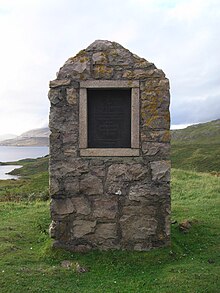John Horne



John Horne PRSE FRS FRSE FEGS LLD (1 January 1848 – 30 May 1928) was a Scottish geologist.[1] He served as president of the Royal Society of Edinburgh from 1915 to 1919.
Life
Horne was born on 1 January 1848, in Campsie, Stirlingshire, the son of Janet (née Braid) and James Horne of Newmill, a farmer. He was educated at the High School, Glasgow, and the University of Glasgow where he studied under Lord Kelvin. He left university without graduating at the age on 19.[2]
In 1867 he joined the Scottish Branch of HM Geological Survey as an assistant and became an apprentice to Ben Peach. The two soon became good friends and collaborators. Horne was involved in mapping the Central Lowlands. Horne was a logical thinker and writer, complementing Peach's skills of resolving the internal structure of mountains by looking at the surface rocks. Thia approach allowed them to resolve a long-running debate on the "Highlands Controversy" in the 1907 publication of The Geological Structure of the North-West Highlands of Scotland. After their work in the Highlands, Horne and Peach wrote 'Northwest Highlands Memoir' in 1907. The work is regarded as one of the most important geological memoirs. Horne wrote most of the memoir himself. From 1901 until 1911, John Horne was the Director of the Scottish Branch of the Survey.[2]
Horne was elected a Fellow of the Royal Society of Edinburgh in 1881, upon the proposal of Sir Archibald Geikie, Sir Charles Wyville Thomson, Peter Tait and Robert Gray, and won the Society's Neill Prize for 1889-92. Horne was very active in the affairs of the RSE and served as Councillor (1902-5; 1906-7; 1914–15), Vice-President (1907–13) and President (1915-19).
Horne was elected a Fellow of the Royal Society of London in 1900 and was a Fellow of the Royal Scottish Geographical Society. He also served as president of the Edinburgh Geological Society.
In 1901, he and Peach contributed a section on Scotland's geology to Francis Hindes Groome's book Ordnance Gazetteer of Scotland: A Graphic and Accurate Description of Every Place in Scotland.
In later life he lived at 12 Keith Crescent in Blackhall, Edinburgh.[3]
He died on 30 May 1928 in Edinburgh.
Family
He was married to Anna Leyland Taylor (d. 1926).[4]
He was grandfather to the psychologist Thomas Arthur Munro.[4]
Recognition
A monument to the work of Peach and Horne was erected at Inchnadamph, close to the Moine Thrust where they did some of their best-known work. The inscription reads: "To Ben N Peach and John Horne who played the foremost part in unravelling the geological structure of the North West Highlands 1883-1897. An international tribute. Erected 1930.".[5] As well as the 1930 memorial at Inchnadamph, a statue of the two geologists was erected at Knockan Crag in 2001.[6]
See also
References
- ^ "Horne, John". Who's Who. Vol. 59. 1907. p. 875.
- ^ a b "Horne, John (1848-1928), geologist". Oxford Dictionary of National Biography (online ed.). Oxford University Press. 2004. doi:10.1093/ref:odnb/37571. (Subscription or UK public library membership required.)
- ^ Edinburgh and Leith Post Office Directory 1911-12.
- ^ a b Biographical Index of Former Fellows of the Royal Society of Edinburgh 1783–2002 (PDF). The Royal Society of Edinburgh. July 2006. ISBN 0-902-198-84-X. Archived from the original (PDF) on 24 January 2013. Retrieved 10 November 2016.
- ^ Historic Environment Scotland. "Inchnadamph, Peach And Horne Memorial (286575)". Canmore. Retrieved 11 March 2022.
- ^ "Monument to Geologists Ben Peach (1842–1926) and John Horne (1848–1928) | Art UK". Discover Artworks. Art UK. 2013. Archived from the original on 12 March 2022. Retrieved 12 March 2022.
External links
- profile Archived 17 March 2014 at the Wayback Machine at www.scottishgeology.com
- Works by John Horne at the Biodiversity Heritage Library
- Works by John Horne at Open Library
- Works by or about John Horne at the Internet Archive
